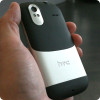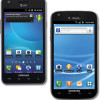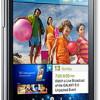Review: Samsung Galaxy S II for T-Mobile
Screen
What's left to say about Samsung's Super AMOLED Plus displays? They're just about the best available from any smartphone. The Galaxy S II's 4.5-inch display looks amazing. It is bright, colorful, rich and warm, and everything looks razor sharp. Rich disagrees. A unit he is testing exhibits a blueish tinge and is rather dim. It offers an excellent space on which to browse the web, watch slide shows, view movies, and read emails.
Signal
The T-Mobile Galaxy S II is the first smartphone that can access T-Mobile's HSPA+ network at the theoretical max of 42Mbps. I tested it along side the HTC Amaze 4G in New Jersey, New York City, and San Diego, and it behaved in much the same way as the Amaze.
In northern New Jersey and New York City, the Galaxy S II showed strong signal performance. It always connected to the HSPA+ network and remained latched on tightly. The device didn't drop any calls, nor did it miss any during my tests. The signal indicator doesn't tell you what speed connection you have (i.e., 14.4Mbps v. 21Mbps v. 42Mbps). Throughout most of my testing, I was in areas covered with 14.4Mbps speeds. I was able to find several areas that offer 42Mbps, however, and in those areas mobile browsing speeds were noticeably faster.
In San Diego, the Galaxy S II fared better than the Amaze did, but only just. It never dropped down to EDGE data speeds, thank goodness, but it never matched the speeds I was able to achieve in the NJ/NYC area.
Sound
The Galaxy S II is an average voice phone on the T-Mobile network. Clarity of voice calls was good, but not perfect. I felt that voices sounded a little distant, and there was a low-level hiss in the background that never seemed to go away. Set to the maximum volume, the earpiece is loud enough for calls in most situations, such as a noisy office or coffee shop. It doesn't have the power to overcome really loud places, such as bars, busy restaurants, or city streets. The speakerphone sounds decent, though it includes the same hiss that the earpiece does. Volume of the speakerphone could definitely be improved, however. It might work in a closed office space, but won't work very well in a car or in a room full of kids. Ringers and alert tones are loud enough to be heard most anywhere, but I wished the vibrate alert were a touch stronger.
Battery
As with most Android smartphones of this caliber, battery life depends a lot on how the device is used, but averages out to about a single day. If you use it meagerly, you can stretch the battery life out to about 36 hours, but you can also gobble up an entire charge in about 6 hours if you're streaming video.
One thing I liked to see was a nicely realized task manager widget. The widget provides a real-time view of how many applications are up and running, and what they're doing to system resources. You can tweak the power savings here and there, but doing that only gets you so far. The bottom line here is you're going to have to charge the device most nights, if not also during the day.


 Hands-On: HTC Amaze 4G, Samsung Galaxy S II 4G for T-Mobile
Hands-On: HTC Amaze 4G, Samsung Galaxy S II 4G for T-Mobile
 Samsung Galaxy S II Coming To AT&T, T-Mobile
Samsung Galaxy S II Coming To AT&T, T-Mobile
 Samsung Galaxy S II Packs 21Mbps HSPA+ , Gingerbread
Samsung Galaxy S II Packs 21Mbps HSPA+ , Gingerbread
 Samsung Galaxy S II / SGH-T989
Samsung Galaxy S II / SGH-T989



